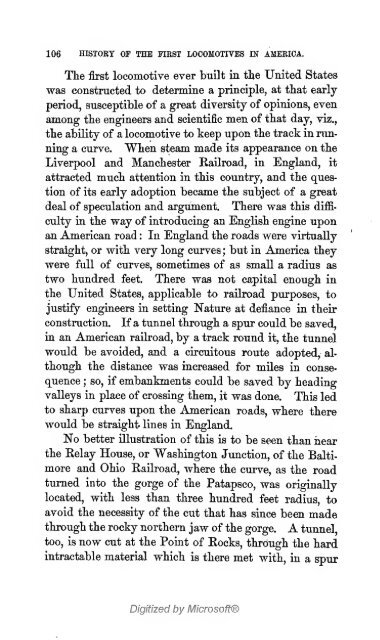The history of the first locomotives in America. From original ...
The history of the first locomotives in America. From original ...
The history of the first locomotives in America. From original ...
You also want an ePaper? Increase the reach of your titles
YUMPU automatically turns print PDFs into web optimized ePapers that Google loves.
106 HISTOKY OP THE FIRST LOCOMOTIVES IN AMERICA.<br />
<strong>The</strong> <strong>first</strong> locomotive ever built <strong>in</strong> <strong>the</strong> United States<br />
was constructed to determ<strong>in</strong>e a pr<strong>in</strong>ciple, at that early-<br />
period, susceptible <strong>of</strong> a great diversity <strong>of</strong> op<strong>in</strong>ions, even<br />
among <strong>the</strong> eng<strong>in</strong>eers and scientific men <strong>of</strong> that day, viz.,<br />
<strong>the</strong> ability <strong>of</strong> a locomotive to keep upon <strong>the</strong> track <strong>in</strong> nm-<br />
n<strong>in</strong>g a curve. When steam made its appearance on <strong>the</strong><br />
Liverpool and Manchester Railroad, <strong>in</strong> England, it<br />
attracted much attention <strong>in</strong> this country, and <strong>the</strong> ques-<br />
tion <strong>of</strong> its early adoption became <strong>the</strong> subject <strong>of</strong> a great<br />
deal <strong>of</strong> speculation and argument. <strong>The</strong>re was this difficulty<br />
<strong>in</strong> <strong>the</strong> way <strong>of</strong> <strong>in</strong>troduc<strong>in</strong>g an English eng<strong>in</strong>e upon<br />
an <strong>America</strong>n road : In England <strong>the</strong> roads were virtually<br />
straight, or with very long curves; but <strong>in</strong> <strong>America</strong> <strong>the</strong>y<br />
were full <strong>of</strong> curves, sometimes <strong>of</strong> as small a radius as<br />
two hundred feet. <strong>The</strong>re was not capital enough <strong>in</strong><br />
<strong>the</strong> United States, applicable to railroad purposes, to<br />
justify eng<strong>in</strong>eers <strong>in</strong> sett<strong>in</strong>g Nature at defiance <strong>in</strong> <strong>the</strong>ir<br />
construction. If a tunnel through a spur could be saved,<br />
<strong>in</strong> an <strong>America</strong>n railroad, by a track round it, <strong>the</strong> tunnel<br />
would be avoided, and a circuitous route adopted, although<br />
<strong>the</strong> distance was <strong>in</strong>creased for miles <strong>in</strong> conse-<br />
quence ; so, if embankments could be saved by head<strong>in</strong>g<br />
valleys <strong>in</strong> place <strong>of</strong> cross<strong>in</strong>g <strong>the</strong>m, it was done. This led<br />
to sharp curves upon <strong>the</strong> <strong>America</strong>n roads, where <strong>the</strong>re<br />
would be straight l<strong>in</strong>es <strong>in</strong> England.<br />
No better illustration <strong>of</strong> this is to be seen than hear<br />
<strong>the</strong> Relay House, or Wash<strong>in</strong>gton Junction, <strong>of</strong> <strong>the</strong> Baltimore<br />
and Ohio Railroad, where <strong>the</strong> curve, as <strong>the</strong> road<br />
turned <strong>in</strong>to <strong>the</strong> gorge <strong>of</strong> <strong>the</strong> Patapsco, was orig<strong>in</strong>ally<br />
located, with less than three hundred feet radius, to<br />
avoid <strong>the</strong> necessity <strong>of</strong> <strong>the</strong> cut that has s<strong>in</strong>ce been made<br />
through <strong>the</strong> rocky nor<strong>the</strong>rn jaw <strong>of</strong> <strong>the</strong> gorge. A tunnel,<br />
too, is now cut at <strong>the</strong> Po<strong>in</strong>t <strong>of</strong> Rocks, thrdugh <strong>the</strong> hard<br />
<strong>in</strong>tractable material which is <strong>the</strong>re met with, <strong>in</strong> a spur<br />
Digitized by Micros<strong>of</strong>t®
















